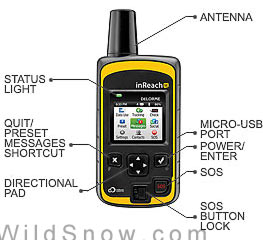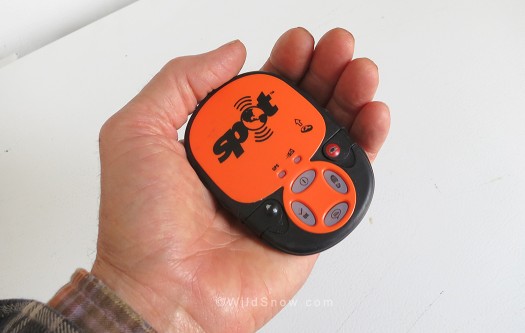Time for another look at SPOT — and more.
First thing, since SPOT is not a 2-way comm device the nagging question always exists: If I trigger the SOS/911 button, can I be sure something will happen? Sure enough to just sit there and wait while staring at the sky trying to imagine the Iridium satellite constellation doing my bidding?
I’d say the answer is yes if you’re in a country with organized rescue services. How it would work in a third-world situation is a different story and one that continues to mystify. My advice is if you want rescue call capability in a place such as Peru, use a 2-way device such as a satphone (or the new inReach SE, see below) and have some phone numbers pre-programmed for people who speak your language and can assist you if you need help (guide services, trekking organizers, etc.).
SPOT emergency calls are handled by an outfit called GEOS located in Houston, Texas. I keep having pictures in my head of how a rescue call is handled there. Would it be a low-wage employee spilling her jumbo Coke as she reaches for her headset? Or are these trained individuals who speak multiple languages and have a huge database of rescue resources at their fingertips (and are drinking multiple espressos instead of sugar syrup)? The GEOS website doesn’t do much to inspire confidence — it has the cookie-cutter feel of a budget web presence, replete with 2011 copyright.
Initial setup went fine for a new unit we got in the family. SPOT website is much improved over several years ago. Even mentions how to cancel an accidental SOS! One gripe is that under the SOS contacts section the web account still only allows two. That’s ridiculous. For example, my wife and I are our son’s main emergency contacts but we frequently travel together out of cell phone range. Thus, Louie needs a third contact in there and that’s not possible. This is a major oversight that SPOT should correct as soon as possible. At least provide three!
When you register a SPOT unit you’ll notice a number of value added options. While some things might be of interest, don’t spend the $12 a year or so on GEOS Member Rescue Benefit “insurance.” Read the fine print and you’ll see that in this case you get what you pay for, meaning you get nearly nothing that at most is a secondary or tertiary benefit to any other insurance policies you have, meaning not only will you get little to nothing if you file a claim, but you may have to wait months or even years if the insurance companies start wrangling. This thing makes me sad. SPOT is a good device that saves lives; to denigrate it with what’s essentially a $12 scam is bogus.
Thing is, if the GEOS benefit is what they imply it is (without being axed by the fine print), it really should be included in the cost of the SPOT unit. But the fact that search and rescue (SAR) is rarely billed to the victim in most areas where the benefit works puts the lie to the deal.
Here in Colorado, we’ve unfortunately had a few avalanche accidents this winter when a SPOT could have played a part. Perhaps not to save lives (due to the need for quick companion rescue along and other issues) but at least to hasten and simplify SAR operations and fulfill what you could call a social contract. But, could you get to your SPOT if you were wrapped up in a tree or otherwise immobilized?
In the recent Sheep Creek tragedy, the lone survivor was trapped in the snow with only one arm free. He waited more than 4 hours for help — a rescue that could have taken much longer if it had not been for the sharp wits of nearby friends. Apparently the survivor couldn’t access his cell phone or presumably an emergency beacon if he’d had one. It’s unknown if the man had either item, but his situation does bring one to ponder the issue: If you do carry a SPOT (or a cell phone in situations where it works for 911) could you access your communication device if you were trapped somehow? I used to think it was geeky to mount your SPOT on a pack strap instead of storing it in the top flap or a pocket. Perhaps not.
Back to the issue of two-way communication. SPOT also sells a unit called the Connect that they call a “satellite communicator.” The name is misleading. Spot Connect is simply a one-way communicator paired with a smart phone — it can send text messages but cannot receive them. Other than the ability to more easily send custom messages (and update brag posts on Facebook), the Communicator is nothing more than a glorified SPOT device that unfortunately requires a battery killing smartphone to work to full potential. Highly unrecommended — just use a SPOT.
Due to its diminutive size, long battery life and a few added features such as the “ok” message and GPS tracking the tried and true SPOT is still a top choice in personal emergency beacons, yet you want to find out if that GEOS phone operator is back from the lunch room yet? Two-way communication.
Two Way Communication — The Future is Now
It’ll cost you more money, but 2-way communication in the backcountry is ultimately what any safety conscious person will want. Go with the new Delorme inReach SE or bit the bullet and start using a satphone if you desire 2-way communication from anywhere.
Delorme essentially uses the Iridium satphone texting system that with an Iridium satphone offers free receiving and pay minutes to send. But the costs of a satphone are stratospheric no matter what: Even a used Iridium 9555 phone will run you around $950 — and the least you’ll pay to keep your satphone functional is around $500 a year, otherwise it becomes a brick. (Other satphone companies exist, but Iridium is the only one with truly global coverage, so they’re the best example — since WildSnow readers are global as well!)

DeLorme inReach SE looks to be one of the best solutions out there.
An inReach SE is about $300 one-time purchase then $300/year to keep it working (plan with enough texting to be practical). We have no doubt SE texts as well as a satphone (and perhaps better due to visible connection indicator), but lack of tactile keypad does not inspire confidence. The basics are there: SOS button and subsequent 2-way comm with the GEOS rescue coordination center (same as used by SPOT). Oh, and it does Bluetooth with a smartphone if you desire for GPS apps and what we hope is a functional mapping system as well as the possibility of rigging with an external keyboard. Quite fully featured, really.
Perhaps inReach SE is the clear choice, but you want voice communication? I can help you with that consideration. We own an Iridium satphone which we’ve been using for more than three years. In deep mountain valleys it is nearly useless for voice as the satellite connections it gets are brief, usually never more than a few minutes, and you have no way of predicting when a connection will occur nor how long it will last.
Sound like something from the 1920s? Yes.
Indeed you can text from your satphone, but guess what? An Iridium phone will not keep a text on hold for automatic sending while waiting for when the phone finally gets a signal. Instead, you have to sit there like a zombie staring at your $1,000 phone LCD until you see it indicating a satellite connection, then send your text. What if you miss your send? You have to wait again, only this time you have to dig your message up via multiple menus that will tax your intelligence. The nail in the coffin is that while you have a message ready to send, you can’t see the connection strength indicator! Lame is putting it kindly. Get an inReach SE or SPOT. (More about inReach plans here.)
(We’ve kept the satphone because it does data, albeit slowly but still effectively for sending photos and blog text from remote locations when paired with a portable computer and solar system. Of course now that we’ve got 3G all the way up Everest, global wireless coverage is probably not far off. In that case, blog posts like this will become paleontological curiosities.)
(By the way, here is how you cancel if you do trigger a SPOT SOS by accident: Press and hold 911/SOS key for 5 seconds, red light flashes, leave unit on and placed with view of open sky.)
Commenters, have you ever triggered a rescue with a SPOT unit?
WildSnow.com publisher emeritus and founder Lou (Louis Dawson) has a 50+ years career in climbing, backcountry skiing and ski mountaineering. He was the first person in history to ski down all 54 Colorado 14,000-foot peaks, has authored numerous books about about backcountry skiing, and has skied from the summit of Denali in Alaska, North America’s highest mountain.

